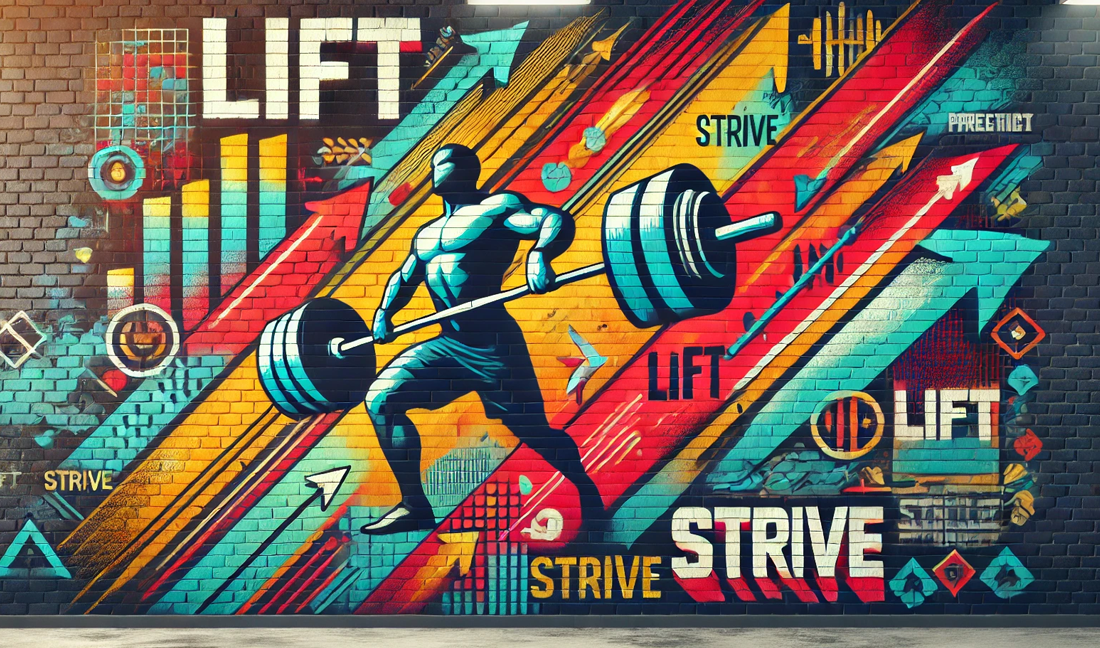Introduction: The Power of Tracking in Weightlifting
In weightlifting, success isn’t just about how much weight you can lift – it’s about understanding the numbers behind your progress. Tracking the top weightlifting metrics allows you to measure performance, identify strengths and weaknesses, and make informed adjustments to your training plan. By focusing on these key indicators, you can train smarter and achieve your goals faster.
Whether you’re aiming to build muscle, increase strength, or improve endurance, tracking metrics provides a clear roadmap for progress. It prevents plateaus, keeps you accountable, and helps you celebrate milestones along the way. In this article, we’ll explore the most important metrics to monitor and how they can elevate your weightlifting game. Let’s dive in!
1. Total Volume: The Foundation of Progress
Total volume is one of the most important metrics in weightlifting, especially for building muscle and strength. It refers to the total amount of work you perform in a workout and is calculated as the product of sets, reps, and weight lifted. For example, if you perform 3 sets of 10 reps with 100 pounds, your total volume for that exercise is 3,000 pounds.
This metric is critical because it directly impacts hypertrophy (muscle growth) and overall training progress. Increasing your total volume over time through a principle called progressive overload challenges your muscles to adapt and grow stronger. It’s not just about lifting heavier weights – it’s about balancing weight, reps, and sets to push your body further while avoiding overtraining.
To track total volume, log the details of your workouts, including the exercises performed, weights used, and the number of sets and reps. Compare your total volume week over week to ensure you’re gradually increasing the workload. If your volume stalls for too long, it may indicate a need to adjust your program or focus on recovery.
Total Volume
Our iPhone app Blaze Workout is a free state-of-the-art fitness app that has Total Volume tracking functionality built-in by default.
Take your workout to the next level!

By consistently monitoring total volume, you can ensure that your training is effective and aligned with your goals. This metric forms the foundation of any successful weightlifting program, helping you progress in strength, size, and performance over time.
2. 1RM (One-Rep Max): Measuring Absolute Strength
Your one-rep max (1RM) is the maximum amount of weight you can lift for a single repetition of a given exercise with proper form. It’s a key metric for assessing absolute strength and serves as the foundation for many weightlifting programs, as it allows you to calculate the appropriate percentages for working sets. For example, you might train at 70–85% of your 1RM to build strength or at lighter percentages for hypertrophy and endurance.
Tracking your 1RM is important because it provides a baseline for your current strength levels and allows you to measure progress over time. As your 1RM increases, it’s a clear indication that you’re getting stronger. Additionally, knowing your 1RM helps you customize your training intensity, ensuring that you’re lifting at the right level for your goals.
To test your 1RM safely, warm up thoroughly with lighter weights and progressively increase the load with lower reps. For example, after warming up, perform 3–5 reps at 60–70% of your estimated max, then 2–3 reps at 80–90%, and finally attempt your max lift. Always use proper form and consider having a spotter or trainer present to reduce the risk of injury.
If testing your actual 1RM feels intimidating, you can estimate it using a repetition-based formula. For instance, if you can lift 200 pounds for 5 reps, your estimated 1RM is approximately 233 pounds ([Weight x Reps x 0.0333] + Weight). This method is safer and still gives you a reliable metric to work with.
1RM (One Rep Max)
The calculation of 1RM and its variations is available in our app Blaze Workout for free. The app will take your latest completed exercises to do all the calculations for you.
Take your workout to the next level!
By regularly tracking your 1RM, you can measure your progress and adjust your program to continually challenge your muscles. It’s a vital metric for serious lifters looking to push their limits and achieve new personal bests.
3. Reps in Reserve (RIR): Gauging Intensity
Reps in Reserve (RIR) is a simple yet effective metric for tracking the intensity of your sets. It refers to the number of repetitions you believe you could still perform before reaching failure. For example, if you complete a set of 8 reps but feel like you could do 2 more, your RIR is 2. This metric helps you gauge how hard you’re working and ensures that your training aligns with your goals.
RIR is particularly valuable because it prevents both undertraining and overtraining. If your sets are too easy (e.g., RIR 4–5), you’re not pushing your muscles enough to stimulate growth or strength. On the other hand, consistently training to failure (RIR 0) can increase fatigue and recovery time, potentially hindering progress over the long term. A sweet spot for most goals is usually RIR 1–3, where you’re working hard but still have a small margin left in the tank.
To incorporate RIR into your training, start by paying attention to how your body feels during each set. As you approach the final reps, ask yourself how many more you could realistically perform with good form. Over time, you’ll develop a better sense of your limits and be able to adjust your effort accordingly.
RIR also makes it easier to adapt your training on days when your energy or strength may vary. For instance, if you feel fatigued but still aim for RIR 2, you can adjust the weight or reps to maintain the intended intensity without compromising form.
RIR (Reps in Reserve)
With Blaze Workout, you can add your own notes to every workout and even on exercise level. This makes it easy to recap information from your previous sessions (like RIR information).
Take your workout to the next level!

By tracking RIR, you can fine-tune your workouts to ensure you’re challenging yourself at the right level. This metric provides valuable feedback on intensity, allowing you to train smarter and make consistent progress while avoiding burnout.
4. Rest Time Between Sets
Rest time between sets is a critical yet often overlooked metric in weightlifting. The duration of your rest periods can significantly impact your workout’s effectiveness, influencing recovery, intensity, and overall performance. Tailoring your rest times to your fitness goals ensures you’re optimizing your efforts in the gym.
For strength-focused training, longer rest periods of 2–5 minutes are typically recommended. This allows your muscles and nervous system to recover fully, enabling you to lift heavy weights with maximum effort in subsequent sets. In contrast, for hypertrophy (muscle growth), shorter rest times of 60–90 seconds help maintain intensity and increase metabolic stress, a key driver of muscle growth. For endurance or circuit-style training, rest periods may be as short as 30–60 seconds to keep your heart rate elevated and improve stamina.
Tracking your rest time ensures consistency and prevents unintentional deviations that can affect your results. For example, taking longer-than-planned breaks during a hypertrophy session could reduce the desired training effect, while rushing through sets in a strength workout might compromise your lifting performance.
To stay on track, use a timer or stopwatch during your workouts. Many fitness apps and wearable devices also include rest tracking features. If you’re training with a partner, be mindful of social distractions, as they can unintentionally extend rest periods.
Adjusting rest times can also be a useful way to progress your training. Gradually shortening rest periods in hypertrophy or endurance training increases difficulty without adding more weight or reps. Conversely, increasing rest in strength training can help you recover more fully for heavier lifts.
Rest Time Between Sets
With Blaze Workout, you can enable a stopwatch to track your rest time between sets. The countdown appears at the bottom of your workout and will inform you when to continue.
Take your workout to the next level!

By tracking and managing rest time, you can align your workouts with your goals and maintain the intensity needed to make consistent progress. This simple metric can have a powerful impact on your overall results.
5. Tempo: The Speed of Your Reps
Tempo refers to the speed at which you perform each phase of a lift, and it’s a key metric for maximizing control, muscle engagement, and overall training effectiveness. Each rep consists of three phases: the eccentric (lowering the weight), the isometric (pausing at the bottom), and the concentric (lifting the weight). Tracking and adjusting your tempo ensures you’re targeting your muscles effectively and optimizing your results.
A common way to express tempo is with a four-number code, such as 3-1-1-0. In this example:
- 3 seconds for the eccentric phase (e.g., lowering the barbell during a bench press).
- 1 second pause during the isometric phase (e.g., holding the barbell at chest level).
- 1 second for the concentric phase (e.g., pressing the barbell upward).
- 0 seconds rest before beginning the next rep.
Slowing down the tempo, especially during the eccentric phase, increases time under tension – a critical factor for hypertrophy. For instance, a controlled 4-second eccentric squat will engage your muscles more than a fast, uncontrolled movement. On the other hand, explosive tempos during the concentric phase can enhance power and athletic performance.
Tracking tempo during workouts requires mindfulness and precision. Focus on executing each phase with control rather than rushing through reps. Many lifters find it helpful to count seconds in their head or use a metronome app to maintain consistency. Writing the tempo in your training log alongside sets and reps helps ensure you’re sticking to the intended pace.
Changing tempo is also a great way to introduce variety into your routine. Slower tempos can make lighter weights feel more challenging, while faster tempos can build speed and power. By tracking and adjusting tempo, you’ll maximize the effectiveness of your lifts and continue making progress in strength, size, and performance.
6. Weekly Frequency: How Often You Train
Weekly training frequency refers to how many days you work out in a week and how often you target specific muscle groups or movements. For weightlifting, finding the right frequency is essential for balancing effective training with proper recovery. Too little frequency can lead to slow progress, while too much can increase the risk of overtraining and burnout.
For most lifters, training each muscle group 2–3 times per week provides an optimal balance between stimulus and recovery. This allows you to work the muscles often enough to promote growth while giving them time to repair and rebuild. For example, a typical split might involve upper body on Monday and Thursday and lower body on Tuesday and Friday, with rest or active recovery on the remaining days.
Weekly frequency also depends on your fitness level and goals. Beginners might start with 3 full-body sessions per week, which provide ample stimulation without overwhelming the body. Intermediate and advanced lifters might progress to 4–6 sessions per week, often using split routines to focus on specific muscle groups or lifts. For strength-focused programs, fewer but more intense sessions might suffice, while hypertrophy goals benefit from slightly higher frequency.
Tracking weekly frequency ensures consistency in your routine. Use a workout log or fitness app to note which muscle groups you train and how often. If progress stalls, assess whether you’re training a muscle group too infrequently or too often and adjust accordingly. For example, if your chest development is lagging, you might increase its frequency from once to twice a week.
Weekly Frequency
With Blaze Workout, you have access to your workout history. This allows you to review your progress over time under different angles (such as visually and tabular).
Take your workout to the next level!
Remember, recovery is as important as training. Scheduling rest days or lighter sessions like yoga or stretching can help you perform better in your main workouts. Weekly frequency is about finding the sweet spot that works for your body and your goals, ensuring steady progress while avoiding fatigue. By tracking and optimizing your frequency, you’ll build a routine that supports long-term success.
7. Range of Motion (ROM): Quality Over Quantity
Range of motion (ROM) refers to how far a joint or muscle moves during an exercise. For weightlifting, using a full range of motion ensures that you’re engaging the target muscles completely and effectively. It’s a critical metric for building strength, improving flexibility, and preventing injuries.
Performing exercises with a full ROM, such as lowering a squat until your thighs are parallel (or lower) to the ground or fully extending your arms during a bench press, maximizes muscle activation. Partial ROM, while useful in specific scenarios like overcoming strength plateaus, often limits the benefits of an exercise and may lead to imbalances over time.
Tracking ROM is vital to maintaining proper form and progress. If your ROM starts to decrease over time, it might indicate that you’re lifting too heavy or compensating with other muscle groups. For instance, in a squat, cutting your depth short to lift heavier weights sacrifices the exercise’s effectiveness and may strain your joints.
To monitor your ROM, consider recording your lifts on video or working with a trainer who can provide feedback. Pay attention to key checkpoints, like how deep you go in a squat or how fully you extend during a deadlift. Using tools like mirrors or apps that analyze movement can also help ensure you’re maintaining proper mechanics.
Improving your ROM often requires addressing mobility and flexibility limitations. Incorporate dynamic stretches, foam rolling, or targeted mobility exercises into your routine to support better movement. For example, if your squats feel restricted, working on hip and ankle mobility can make a significant difference.
Ultimately, ROM emphasizes the quality of each rep over the quantity of weight lifted. By prioritizing and tracking your range of motion, you’ll not only reduce the risk of injury but also ensure that your workouts are as effective as possible for building strength and muscle.
8. Progressive Overload: The Key to Growth
Progressive overload is the cornerstone of muscle growth and strength development. It involves gradually increasing the demands placed on your muscles over time, forcing them to adapt and become stronger. Without progressive overload, your muscles won’t receive the stimulus needed to grow, and your progress will plateau.
There are several ways to implement progressive overload in your training:
- Increase Weight: Gradually add more weight to your lifts as you become stronger. For example, if you’re bench pressing 100 pounds for 8 reps, try increasing to 105 pounds the following week while maintaining good form.
- Add Reps or Sets: Perform more repetitions or additional sets at the same weight. This increases total volume, which is crucial for muscle hypertrophy.
- Improve Tempo or Range of Motion: Slowing down your reps (e.g., a 3-second eccentric phase) or using a full range of motion can increase the intensity of an exercise without adding weight.
- Reduce Rest Time: Shortening rest periods between sets can increase workout density and challenge your muscles further.
Tracking progressive overload is essential to ensure you’re consistently pushing your limits. Use a workout log or fitness app to record weights, sets, and reps for each exercise. Regularly review your data to identify trends and ensure that your workload is increasing over time. If you find your progress stalling, consider switching exercises or adjusting your training variables.
While progressive overload is vital, it’s important to balance it with proper recovery. Adding too much weight or volume too quickly can lead to overtraining, fatigue, or injuries. Make gradual adjustments and listen to your body, ensuring you’re challenging yourself without compromising form or health.

By focusing on progressive overload, you’ll create a consistent cycle of improvement, helping you build muscle, gain strength, and achieve your fitness goals. This simple yet powerful principle is the foundation of any effective weightlifting program.
9. Recovery Metrics: Beyond the Gym
Recovery is where the real growth happens. While intense workouts provide the stimulus for muscle development, it’s during recovery that your body repairs, rebuilds, and grows stronger. Tracking recovery metrics ensures that you’re allowing adequate time for your muscles to heal and optimizing your performance in subsequent workouts.
Key Recovery Metrics to Track
- Sleep Duration and Quality: Sleep is critical for recovery, as it’s when your body repairs tissues and balances hormones. Aim for 7–9 hours of quality sleep per night and track your sleep patterns using wearable devices or apps. Poor sleep can lead to decreased performance and slower progress.
- Perceived Soreness: Track how sore you feel after workouts. While mild soreness is normal, persistent or severe soreness may indicate overtraining or inadequate recovery.
- Energy Levels: Consistently low energy can be a sign of under-recovery. Monitor how you feel throughout the day and during workouts.
- Heart Rate Variability (HRV): HRV measures the variation in time between heartbeats and is a useful indicator of your body’s readiness to train. Higher HRV generally signals better recovery, while lower HRV suggests you may need more rest.
- Resting Heart Rate (RHR): An elevated RHR can indicate fatigue or overtraining. Track your RHR in the morning to spot trends.
How to Optimize Recovery
Tracking recovery metrics isn’t just about observing data—it’s about taking action to improve your rest and repair processes:
- Hydration: Ensure you’re drinking enough water daily to support metabolic processes and muscle recovery.
- Nutrition: Consume a balanced diet with sufficient protein, carbs, and fats. Post-workout meals should include protein for muscle repair and carbs to replenish glycogen stores.
- Active Recovery: Incorporate light activities like walking, swimming, or yoga to promote blood flow and reduce stiffness.
- Stress Management: Chronic stress can hinder recovery, so practice mindfulness, meditation, or relaxation techniques to support your body’s healing process.
Adjusting Based on Recovery Data
By monitoring recovery metrics, you can adjust your training intensity and frequency as needed. If you notice signs of under-recovery, such as poor sleep or persistent soreness, scale back on your workouts or take an additional rest day. Conversely, if recovery metrics show you’re well-rested and energized, you can confidently push harder in your next session.
10. Personal Bests: Tracking Milestones
Tracking personal bests (PBs), also known as personal records (PRs), is one of the most motivating and rewarding aspects of weightlifting. A personal best represents your peak performance in a specific exercise, whether it’s the most weight you’ve lifted, the highest number of reps completed, or a new endurance benchmark. These milestones not only measure progress but also inspire confidence and a sense of achievement.
Why Personal Bests Matter
Recording PBs allows you to see tangible evidence of your hard work and dedication. As you progress, hitting new PBs shows that your strength, endurance, and overall fitness are improving. These achievements keep you motivated and focused on continuing your journey. Tracking PBs also provides valuable insights into your training effectiveness, helping you identify areas where you’re excelling and where you might need to improve.
What to Track
- Maximum Lifts: Record your heaviest successful lifts for compound movements like squats, bench presses, deadlifts, and overhead presses.
- Rep Maxes: Track the most reps you can complete at a specific weight (e.g., 10 reps at 150 pounds).
- Time or Endurance Goals: For circuits or timed sets, note your fastest completion time or the highest number of rounds performed.
- Bodyweight Progress: If applicable, track calisthenics milestones, such as completing your first pull-up or increasing push-up volume.
How to Track and Celebrate
Keep a dedicated log of your PBs, whether in a fitness journal, spreadsheet, or app. Record the date, exercise, weight, reps, and any relevant notes, such as how you felt during the lift. Update your records regularly to reflect progress.
Celebrate each PB as a milestone in your fitness journey. Rewards, like new gear or a cheat meal, can keep you motivated to strive for the next achievement. Sharing your PBs with friends, workout partners, or fitness communities can also provide encouragement and support.
Pushing Beyond Personal Bests
Once you’ve achieved a PB, set a new goal to keep challenging yourself. Use progressive overload techniques – like adding weight, increasing reps, or improving form – to gradually push your limits. Be patient and consistent, as PBs often take time to surpass.
Conclusion: Lift Smarter, See Better Results
Tracking the top weightlifting metrics is the key to transforming your workouts from guesswork into a strategic, results-driven process. By monitoring critical indicators like total volume, 1RM, RIR, and recovery metrics, you can ensure your training is efficient, effective, and aligned with your goals. Each metric offers valuable insights into your performance and progress, empowering you to lift smarter and achieve better results.
Remember, success in weightlifting isn’t just about lifting heavier weights – —it’s about consistency, precision, and the willingness to adapt. Whether you’re hitting personal bests, optimizing tempo, or refining your recovery, tracking metrics helps you stay accountable and motivated.
Start integrating these metrics into your routine today. With a smart, data-driven approach, you’ll avoid plateaus, improve your performance, and unlock your full potential. Lift smarter, train harder, and watch your results soar!












5 thoughts on “Lift Smarter, not Harder – Top Weightlifting Metrics”
Comments are closed.